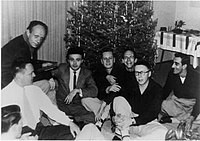An unfortunate result of being gay in the 1950s and 60s was having to reside one’s sexual desires in almost complete secrecy. There were always the few brave souls who were unapologetic about themselves in the public sphere, such as Tennesse Williams or Truman Capote. However, most gay men and women realized early on that their real self was not safe to be practiced in the open. So, it should come as no surprise that the leading gay organization of the 50s and 60s, the Mattachine Society, existed for much of the time in almost complete secrecy.
At first, the New York Mattachine Society started on 1133 Broadway, right near Madison Square, operating as a safe haven for New York City’s more intellectual closeted gay men.1 However, after the events of the Stonewall Riots, the organization decided to move its office to 59 Christopher Street, in the middle of the intersecting neighborhoods of the West Village and Greenwich Village.2Up until the late 70s, it would operate as one of New York City’s many gay organizations fighting in what was called at the time the Gay Liberation Movement. However, the history of the Mattachine Society is not solely confined to the island of Manhattan. In fact, the Mattachine Society was not only a gay organization for New York, but for much of the country.
Although started by many people, the man arguably most responsible for the beginning of the Mattachine Society was Henry Hay. Born in England to American parents, Hay spent much of his childhood contemplating his sexuality and his attractions towards men.3 During the 30s, thanks to the connections he had built with the large amount of closeted men in Los Angeles, Hay became increasingly politically active. Feeling the wrath of the Great Depression, he joined his local Communist Party in San Francisco and participated in labor strikes and demonstrations.4 However, Hay would soon have a falling out with the Communist Party and its leaders. Learning of Stalin’s reversal on Homosexual acceptance, Hay decided to reveal his Homosexuality to party superiors who in turn told him to suppress it.5 Hay would soon split from the group and decide to venture out and find a leftist organization more comfortable with his homosexuality.
At first the Mattachine Society acted as a series of small group discussions between Los Angeles’ gay community. Started while he was married and parenting a kid, Henry Hay would drop his daughter off at dance class and then wander around the gay communities of Los Angeles handing out fliers to anyone who would take them.6 In its early stage, the Mattachine Society reflected what Hay had learned while enrolled in the Communist Party. It believed in a hierarchy of leadership, expressing the message of an oppressed people or a cultural minority, and called for the mass mobilization of gay people in order to combat the oppression of the United States government.7 Coinciding with this came the agreement that many leftists organizations had arrived at during the 50s: that their group must remain secret until the second red scare, led by Senator McCarthy, came to an end. This became of extreme importance when the Senate, during the active status of the House of Un-American Activities, published its report “sexual perverts”. “Sexual Perverts” was a dossier that described the nature of homosexual activities, using a tone that signaled that such actions were perverted and unnatural.8

Following the first chapter in Los Angeles in ’50 and the organization of small meetings in ’53, Hay and Society members looked to establish a chapter in New York City. The chapter was opened in 1954 by a Cuban research chemist named Tony Segura, and a clinical psychologist- who had come out in the early 20s- named Sam Morford.9Around this time the Mattachine Society also began publishing a magazine called ONE, a critical analysis of the homosexual life in the United States.10 Much like the society that published it, ONE magazine was published secretly to avoid attracting law enforcement and other authorities. Because of this, in big cities such as Los Angeles, Chicago, or New York, someone could only get the magazine from one or two newsstands, making its audience relatively small. Due to its small readership, the magazine would cease to exist in 1967, but ONE Institute would remain as an educational wing of the gay rights movement.11
With the sudden increase in growth and visibility, the Mattachine Society began dialing back some of its rhetoric that would be seen as radical in the eyes of the wider public. During a May Convention in 1953, the new leadership of Kenneth Burns, Marilyn Rieger, and Harold Call, promoted a message far more conservative than the one initiated by Harry Hay:
“a pattern of behavior that is acceptable to society in general and compatible with the recognized institutions … of home, church and state.”12
With this new message, the Mattachine Society’s leaders put the message of revolution in the past and now advocated, what many of its members called, assimilation. Thanks to this message, the society, especially the branch in New York City, would fall into turmoil and lead to its decline in membership.
When Craig Rodwell arrived in New York City in 1958, he was eager to join an organization like the Mattachine Society.13 However, upon applying at its first office on 1133 Broadway, Rodwell was told that he had to be 21 or older to be a member- he was 18 at the time- but he could still attend the meetings and help out within the office.14 However, in the eyes of Craig Rodwell this opportunity would turn out to be disappointing. Craig Rodwell, like many of the young people during the late 50s, and throughout the 60s, yearned for revolution and justice, instead he found the meetings to be too educational:
“The more meetings Craig attended, the more his dismay grew. He discovered that New York Mattachine had decided to confine its operations to two areas, education and research, and had disclaimed political agitation as counterproductive.”15
Along with many members at the time, Craig had seen a once radical organization turn into an educational club for those over the age of 40. Along with the society’s newfound conservatism, the organization would see decline in the radical 60s and free loving 70s.

Although the Mattachine Society, especially the New York Branch, would flirt with a more militant conglomerate in the mid-60s, each individual branch would never climb to a membership numbering more than 500 people.16 This time would also see the end of the society’s before mentioned ONE magazine. With leftists of the 60s focusing their attention on the Jim Crow south and the Vietnam War, the labor and gay rights movements would not receive a wider attention until the early 70s. Thanks to this honing of America’s left, the Society would see its New York branch fall in 1976 due to a decline in membership and its growing costs that lead to bankruptcy.17 . It would experience some of the revolutionary spotlight due to its organized sip in of Julius’s Bar in 1966, but never any more after that event.
Started by Harry Hay in 1950 in Los Angeles, the Mattachine Society would operate during as a revolutionary organization that was forced to conduct its agenda in secrecy. Although containing a small readership, its magazine ONE, would provide a glimpse into the secret life of many of Los Angeles, Chicago, and New York’s closeted gay men. It would experience inner turmoil during the 1960s, and see its demise in the 70s, but the Mattachine Society will remain in history as one of the gay rights movement’s leading organizations. Its New York branch, especially after the riots at Stonewall, would operate as a safe haven for the country’s most closeted men.
- NYC LGBT Historic Sites Project, Organizations and Community Spaces, Mattachine Society and the Daughters of Bilitis Offices, https://www.nyclgbtsites.org/site/mattachine-society-daughters-of-bilitis-offices/, Accessed March 23, 2020.
- NYC LGBT Historic Sites Project, Organizations and Community Spaces, Mattachine Society Office, https://www.nyclgbtsites.org/site/mattachine-society-office/, Accessed March 23, 2020.
- John D’emilio, Sexual Politics, Sexual Communities, (Chicago, IL: University of Chicago Press, 1983), 58.
- Ibid., 59.
- Ibid.,59.
- The Progressive, Anne-Marie Cusac, Meet the Pioneer of Gay Rights, Harry Hay, https://progressive.org/magazine/meet-pioneer-gay-rights-harry-hay/, Accessed, March 23, 2020.
- John D’emilio, Sexual Politics, Sexual Communities, (Chicago, IL: University of Chicago Press, 1983), 63.
- Ibid., 64.
- Ibid., 90.
- Martin Duberman, Stonewall, (New York, NY: Plume, 1993), 48.
- University of Southern California, ONE Archives at the USC Library, History, https://one.usc.edu/about/history, Accessed March 23, 2020.
- John D’emilio, Sexual Politics, Sexual Communities, (Chicago, IL: University of Chicago Press, 1983), 81.
- Martin Duberman, Stonewall, (New York, NY: Plume, 1993), 78.
- Ibid., 79.
- Ibid., 80.
- John D’emilio, Sexual Politics, Sexual Communities, (Chicago, IL: University of Chicago Press, 1983), 173.
- NYC LGBT Historic Sites Project, Organizations and Community Spaces, Mattachine Society and the Daughters of Bilitis Offices, https://www.nyclgbtsites.org/site/mattachine-society-daughters-of-bilitis-offices/, Accessed March 23, 2020.